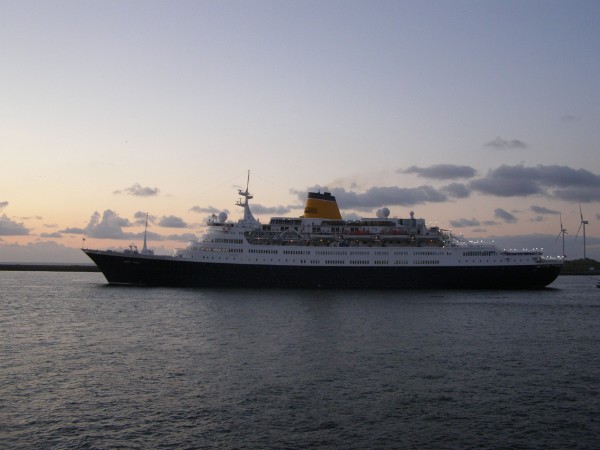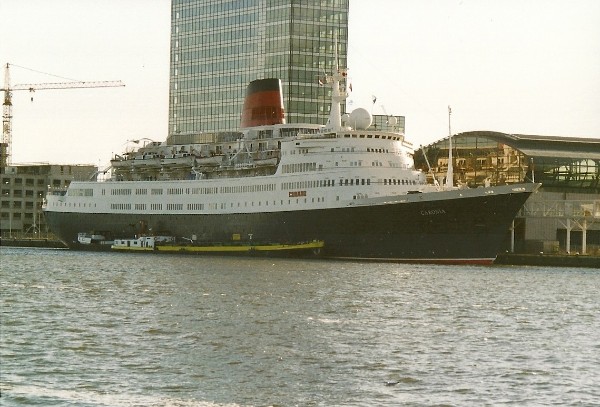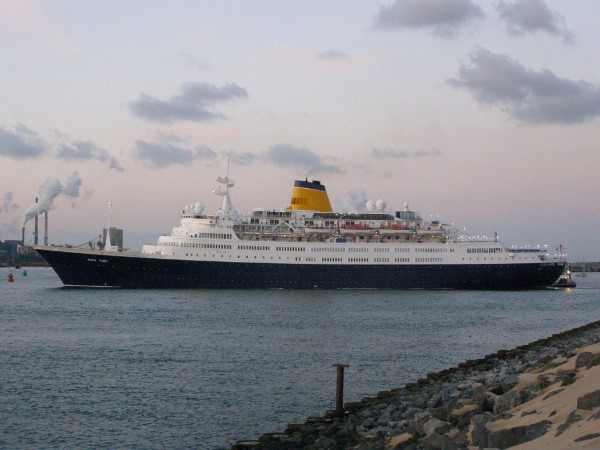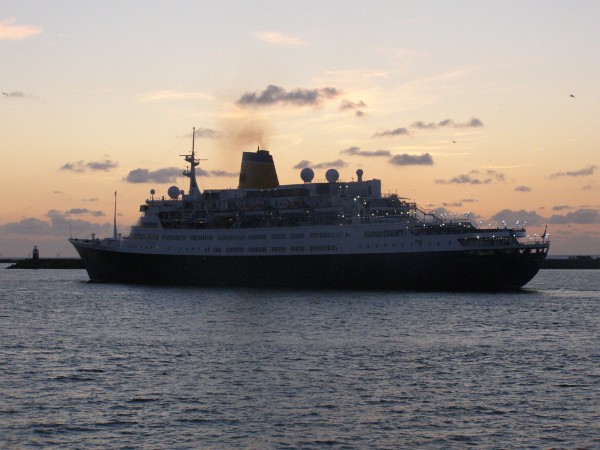Saga Ruby

On the 15th of may 1972, Norwegian America Line launched their last liner from the Swan Hunter Shipbuilders wharf at Wallsend, northern England. This wharf had produced many high-rated ships, the most famous one of course was Cunard's first Mauretania in 1906. But because of the end of transtatlantic travel the building of passengerships in Britain came virtually to a close in the 1970's. This Norwegian American ship from 1972 was the very last passengerliner to be built at the Tyne. Although several other passengerliners have been built in Britain after her, the last one now is Curnow Shipping's St.-Helena that was built in Aberdeen at the A.P. Appledore wharves in 1989.
The later Saga Ruby was very similar to the Sagafjord, that had also been built for the Norwegian America Line at the Forges et Chantiers de la Mediterrannee yards at La Seyne, France in 1964. The new 1972-built ship was to be NAL's very last true liner, although she was also mainly used as a cruiseship and only made a few traditional crossings in between her cruises. So the ship, built as yardnumber 39, was to be a cruiseship only, but she was designed like a classic oceanliner with very conservative looks.
The ship was named Vistafjord, this was the second time this name was used by the company, and she had accomodations for 670 passengers in one class. Some 390 crewmembers catered for them, and with this passenger to crew ratio you can imagine that the ship was to be operated in the high-end of the market. Of course line-voyages were in a state of decay, so NAL really tried to put themselves in the luxury cruise business. The ship measured some 24.292 tons, a little larger than her earlier sister. She had a lenght of 191,09 meters, a width of 25 meters and a draft of 8,2 meters. She was designed for a moderate speed of 20 knots, propelled by two screws driven by two 9-cilinder diesel engines.
Vistafjord sailed her trials at the 6th of april 1973, and was delivered to Norwegian America Line at the 15th of may 1973, exactly one year after her launch. She sailed on her first voyage, that was to be a classic Oslo-New York sailing, departing Oslo at the 22nd of may. This journey was followed by a short cruise from New York to Nassau at the Bahama's, and after that she started to sail worldwide cruises. Sometimes, she did sail a voyage from Oslo to New York, but this was clearly not the main focus and these journeys were really advertized as cruises, not line-voyages.
From may 1980 onwards, Norwegian America Line restyled itself as Norwegian America Cruises after the struggling company had been bought by the Oslo-based Leif Hoeg & Co., mainly known for their car-carriers. Their new name indicated that the company had changed from their early liner-origins. With their two-ship fleet, Sagafjord and Vistafjord they operated two of the most luxury cruiseliners of the day and the company had a very loyal following and good name. But the 1980's were not the best decade financially, as many shippinglines were really having hard times to fill their ships, especially the older lines like Holland America, Norwegian America, Cunard and P&O. They still exsisted, but they had a hard time beating up to the modern cruiselines that aimed at younger passengers and were more easy adapting to the new shipping-climate. So Norwegian America Line's new owners were looking for a partner in the early 1980's, and their first option was the Royal Viking Line, an also high-rated Norwegian cruiseline. There were plans to merge these lines as one under the banner of the Royal Viking Line, and for this newly restyled line, Vistafjord was planned to be renamed Royal Viking Vista and Sagafjord was to become the Royal Viking Saga. But this deal collapsed in the early stages, but a new deal was found when Cunard Line stepped in and took over the NAL and their two-ship fleet. Because of the good name of the line, Cunard decided that it was best to retain the names of the ships and a division called Cunard-NAL was formed to manage them. The Norwegian crews were also taken over and the only real difference from their Norwegian America Cruises days were the new funnelcolours, the traditional red and black of Cunard. Also, the homeport changed from Oslo to Nassau. In 1986, the NAL-suffix dissappeared and the ships were now operated by Cunard Line itself. After a few succesfull years under their new owners, their Norwegian origins were not the extra touch anymore.

As Caronia, the ship visited Amsterdam at the 17th of december 2003. You can see that the Cunard-colours really fit her well, re-creating something of the old Cunard Line after the year 2000.
The ships sailed steadily on for Cunard Line, still attracting many repeat-passengers. They started to become true classic icons in the cruise-industry, being designed as already out-of date looking liners. Sometimes, being out-of date from the beginning can really add pluspoints later on, I suppose! In 1996, the oldest of the sisters, Sagafjord, suffered a fire near the Phillipines, and Cunard Line decided to take the ship out of service. At that time she was still able to be repaired, on her way to the wharf at Singapore, the stricken ship even took over 26 crewmembers from the Turkish freighter Harran, that had sunk. When repaired, the ship was chartered out to Transocean Tours of Germany as Gripsholm, before she was sold to Saga Shipping. This British company catered for elderly passengers and this elderly ship was a great choice. The perfect combination of the former name of the ship and the name of this company were purely a coinsidence.
Vistafjord still sailed happily for Cunard Line, well into the end of the 1990's. But Cunard Line itself had many changes to come. In 1998, the line was sold by the Kvaerner Group of Norway, that were the owners at the time, to the Carnival Corporation. This was a good move, although somemight say Carnivore Cruise Lines because of their expansiondrift. But nobody can argue about the fact that under Carnival-management, Cunard Line was getting back some of its former glory, after the company really did decline in the last decades. Although investments weremade, no new ships had been built for Cunard Line in around 20 years and the company was a gathering of several kinds of ships and funnelcolours. Carnival decided to concentrate on the lines great history and replaced most of the ships of Cunard into other parts of the Corporation. Just two ships would be sailing for Cunard Line, the classics. Next to the last true liner in the world Queen Elizabeth 2, this was to be Vistafjord. On the 10th of december 1999, just before the millennium-celebrations, the last true link with Norwegian America Line dissappeared when the ship was renamed Caronia, the thirth time this name was used in Cunard-history. Because of the signifigance of this move, the ship was renamed at a historic spot for the line, the Landing Stage at Liverpool, right in front of the old Cunard Building that still dominates the Liverpool skyline. The renaming was done by Pam Conover, Cunard CEO, because Madelaine Arison was ill. During the ceremony, the Liverpool Philharmonic played 'Rule Britannia', 'Land Of Hope and Glory' and several Chrismas carols. Afterwards, there were fireworks from Caronia's forecastle, the Cunard building and later mid-river. Of course it was sad to loose the last part of NAL-heritage, but for Cunard Line it seemed to be the best. The ship, although almost 30 years old, still proved to be an important part for the re-incarnation of the great Cunard fleet. Her homeport also became the traditional port of Southampton and it was very cool to have a Cunard-'ia' ship back on the seas.

Carnival invested more in the fleet of Cunard Line, when they brought into service the new flagship and largest passengership in the world Queen Mary 2. I must say this was a very exciting time, because it really felt that Cunard Line came back on track. It was the first time in 26 years a new Cunarder was built. Although she would really be a replacement for the 1969-built, stunning but aging Queen Elizabeth 2, it was Caronia that was leaving the fleet in november 2004. She served some 21 years for Cunard Line and had become a true classic. To great relief, the ship was given a new lease of life for Saga Holidays, where she met her former NAL partner Sagafjord, now named Saga Rose. For Saga, Caronia was renamed Saga Ruby and was used in the less extensive market around Great Britain, sailing cruises for elderly passengers, like her sister. She was rebuilt and given the latest updates in safety-requirements and started sailing from Southampton to the Caribbean in march 2005. Normally, she would sail European cruises in summer and in winter Caribbean sailings. I was very pleased to meet the ship on an evening at IJmuiden at the 13th of june 2012, the date these pictures were taken. Just recently was announced that 2013 will be the last season for the true classic liner. Her sister Saga Rose had been taken out of service in 2009 because it seemed to be not feasable to bring her up to the 2010 SOLAS-requirements. She was finaly scrapped in 2011. It was very likely that Saga Ruby, one of the last examples of classic passenger shipbuilding would be following her to the breakers when her services ended.

During her last season, just before the ship was about to sail for her World Cruise, a problem with the crankshaft on one of the two engines was discovered and the captain had to delay the departure for her cruise. It was very sad for the company to delay her final world cruise, and a new itinerary was now put in place, and she finally set sail from the 20th of february onwards. At the 7th of december 2013, she departed Southampton for her Farewell Cruise for Saga Cruises and all went well untill she was to depart Tenerife , before setting sail for the Caribbean. In Tenerife, it was discovered that there was a problem with the generator for the airconditioningsystems. After searching for the best solution to this problem, it was decided that the cruise would be changed and she would not sail for the hot Caribbean but for the somewhat cooler Mediterranean where a failure in the airconditioning wouldn't be that bad. On the 9th of january 2014, the ship arrived for the last time at Southampton from where she left one day later for Gibraltar.
Instead of being sold to the breakers, the ship was offered a new lease of life by a company based at Singapore, Malaysia. For $14 million she was bought by Millennium View Ltd. for use as a hotelship at Myanmar, a.k.a. Burma. For this, she was quickly drydocked at Gibraltar, with work finalized at the 31st of januari 2014. At the 4th of february, her new name Oasia was painted on her bows and stern and soon afterwards she started sailing her deliveryvoyage to the Far East. After several anchorplaces near Thailand and a trip to the straits of Singapore and back, it seemed that she was a little lost in this far away place. In late 2015, the ship was laid-up in Pattaya, Thailand and nothing significant was happening with her. That untill the beginning of march 2017. At the 5th of march, the ship finally left her moorings, firstly heading for Singapore again, then going onwards to the Indian beach of Alang. Here, she arrived in early april and she was finally beached at the 12th of april. With her departure, the world lost another ghreat classic icon from the cruisefleet.

